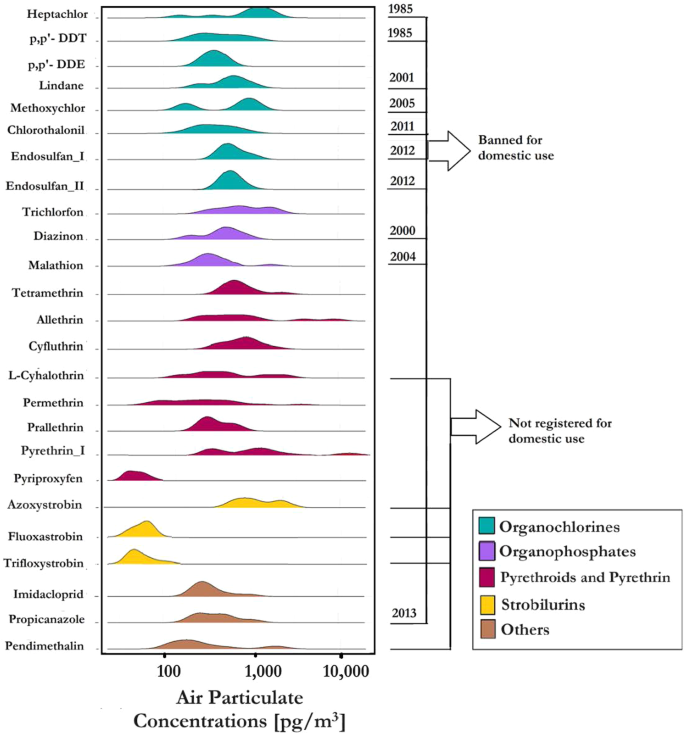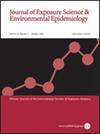低收入住房中普遍存在杀虫剂。
IF 4.7
3区 医学
Q2 ENVIRONMENTAL SCIENCES
Journal of Exposure Science and Environmental Epidemiology
Pub Date : 2024-06-22
DOI:10.1038/s41370-024-00665-y
引用次数: 0
摘要
背景:住在由政府或政府资助机构补贴的社会福利房中的低社会经济地位(SES)居民可能会对室内住宅中使用的杀虫剂有更高的暴露量,因为杀虫剂的使用是由于结构缺陷、维护不善等原因造成的。目标:估算 20 世纪 70 年代建造的低社会经济地位社会福利房中的居民对遗留和当前使用的杀虫剂的暴露量,并调查与暴露量相关的因素:2017年,使用便携式空气净化器对加拿大多伦多7栋低收入社会住房、多单元住宅楼(MURBs)中46个单元的室内空气中的28种颗粒相杀虫剂进行了测量。分析的杀虫剂包括传统和当前使用的有机氯类、有机磷类、拟除虫菊酯类和石硫合剂类:89%的单位至少检测到一种农药,单种农药的检测频率(DF)高达50%,包括遗留的有机氯和当前使用的农药。当前使用的拟除虫菊酯的检测频率和浓度最高,其中颗粒相浓度最高的拟除虫菊酯 I 为 32,000 pg/m3。七氯于 1985 年被限制在加拿大使用,估计其在空气中的最高总浓度(颗粒相加气相)为 443,000 皮克/立方米。七氯、林丹、硫丹 I、百菌清、甲氰菊酯和氯菊酯(一项研究除外)的浓度高于其他地方报告的低收入住宅中测得的浓度。除了有意使用杀虫剂来控制害虫以及在建筑材料和涂料中使用杀虫剂外,吸烟与烟草作物上使用的五种杀虫剂的浓度也有显著相关性。高 DF 值杀虫剂在个别建筑中的分布表明,建筑管理部门的除虫计划和/或居民使用杀虫剂是测量到的杀虫剂的主要来源:影响:低收入社会住房满足了人们的迫切需要,但这些住宅容易受到虫害侵扰,因此也容易使用杀虫剂。我们发现,在所有接受检测的 46 个单元中,89% 的单元至少接触了 28 种微粒相杀虫剂中的一种,其中当前使用的拟除虫菊酯和长期禁用的有机氯(如滴滴涕、七氯)的 DF 值和浓度最高,这是因为它们在室内的持久性非常高。此外,还测量了几种未注册用于室内的杀虫剂,如用于处理建筑材料的石硫合剂和用于烟草作物的杀虫剂。这些结果是加拿大首次获得的关于室内大多数杀虫剂的数据,表明人们广泛接触到多种杀虫剂。本文章由计算机程序翻译,如有差异,请以英文原文为准。


Widespread occurrence of pesticides in low-income housing
Low socioeconomic status (SES) residents living in social housing, which is subsidized by government or government-funded agencies, may have higher exposures to pesticides used in indoor residences since pesticides are applied due to structural deficiencies, poor maintenance, etc. To estimate exposure of residents in low-SES social housing built in the 1970s to legacy and current-use pesticides and to investigate factors related to exposures. Twenty-eight particle-phase pesticides were measured in the indoor air of 46 units in seven low-income social housing, multi-unit residential buildings (MURBs) in Toronto, Canada using portable air cleaners deployed for 1 week in 2017. Pesticides analyzed were legacy and current use in the classes: organochlorines, organophosphates, pyrethroids, and strobilurins. At least one pesticide was detected in 89% of the units with detection frequencies (DF) for individual pesticides of up to 50%, including legacy organochlorines and current-use pesticides. Current-use pyrethroids had the highest DF and concentrations, with the highest particle-phase concentration for pyrethrin I at 32,000 pg/m3. Heptachlor, restricted for use in Canada in 1985, had the highest estimated maximum total air (particle plus gas phase) concentration of 443,000 pg/m3. Heptachlor, lindane, endosulfan I, chlorothalonil, allethrin, and permethrin (except in one study) had higher concentrations than those measured in low-income residences reported elsewhere. In addition to the intentional use of pesticides to control pests and their use in building materials and paints, tobacco smoking was significantly correlated with the concentrations of five pesticides used on tobacco crops. The distribution of pesticides with high DF in individual buildings suggested that pest eradication programs by the building management and/or pesticide use by residents were the major sources of measured pesticides. Low-income social housing fills a much-needed demand, but the residences are prone to pest infestation and hence pesticide use. We found exposure to at least 1 of 28 particle-phase pesticides in 89% of all 46 units tested, with the highest DF and concentrations for current-use pyrethroids and long-banned organochlorines (e.g., DDT, heptachlor) due to very high persistence indoors. Also measured were several pesticides not registered for use indoors, e.g., strobilurins used to treat building materials and pesticides used on tobacco crops. These results, which are the first Canadian data for most pesticides indoors, show widespread exposure to numerous pesticides.
求助全文
通过发布文献求助,成功后即可免费获取论文全文。
去求助
来源期刊
CiteScore
8.90
自引率
6.70%
发文量
93
审稿时长
3 months
期刊介绍:
Journal of Exposure Science and Environmental Epidemiology (JESEE) aims to be the premier and authoritative source of information on advances in exposure science for professionals in a wide range of environmental and public health disciplines.
JESEE publishes original peer-reviewed research presenting significant advances in exposure science and exposure analysis, including development and application of the latest technologies for measuring exposures, and innovative computational approaches for translating novel data streams to characterize and predict exposures. The types of papers published in the research section of JESEE are original research articles, translation studies, and correspondence. Reported results should further understanding of the relationship between environmental exposure and human health, describe evaluated novel exposure science tools, or demonstrate potential of exposure science to enable decisions and actions that promote and protect human health.

 求助内容:
求助内容: 应助结果提醒方式:
应助结果提醒方式:


